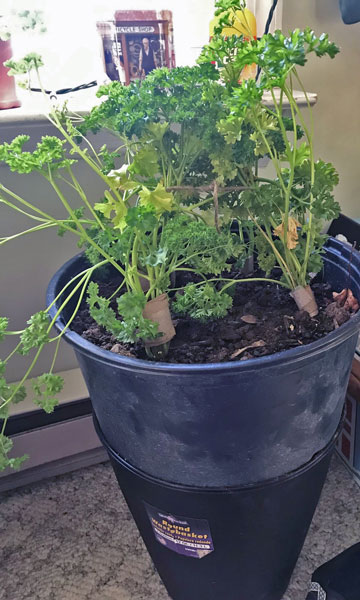“Helping You Find Plants That Work”
by Ana Morlier, The Crazy Plant Lady
Now that we’re all finally past the craziness of the holidays, we can sit back and relax, right? More often than not, our schedules get packed all over again with work and school. It seems like the stress never ends. But there is one way to help you alleviate stress, start your own creativi-tea and have fun!
Note: WARNING. LOTS OF TEA PUNS AHEAD.
Aaahhh…Sereni-tea
Tea has a slew of benefits: it aids in gut health, keeps you (deliciously) hydrated, and can improve oral health. Simply taking a moment to make tea and enjoying it is a great way to practice mindfulness and take a time-out from the business of daily life.
You don’t need to go to a fancy tea shop for some loose-leaf teas. You can grow and make your own! It’s not impossible to grow plants during January, even though it may frost-tea. Your house keeps you—and your plants—quite toast-tea. So, let’s get to how you can get growing.
Some great tea herbs you can grow include mint, lavender, lemon verbena, fennel, lemon balm, rose hips, chamomile, rosemary, and sage, just to name a few.
There’s No Place Like Home (for your planty friends)
Before you select your plants, make sure you have well-draining soil. About half an inch to one inch of pebbles at the bottom works. Slots or holes at the bottom can also do the trick (you can drill holes at the bottom if necessary). For these, make sure you have a stand that can elevate the pot so there is space underneath, and make sure to place a paper towel underneath. Try for lighter potting soil, but regular soil is sufficient. Herbs don’t really grow too deep, so a container three to five inches deep will suffice. The container can be as wide and long as you’d like.
Most herbs require five to six hours of sunlight (a grow light can be used in place of sunlight). If you grow thyme, make sure your little buddy gets eight hours of sunlight.
Moderate indoor temperatures are required, along the range of 60-70 degrees.
Winter is also the worst time for humidity, as you may have noticed based on extremely dry hands (my family has to constantly lotion their hands. More often than not, the claim of “24-hour moisture” is a lie). You can go and get a fancy humidifier if you want. You can use it for many years for your plants and yourself, but you can also make your own for much cheaper:
Put a sponge in a bowl, let it soak up as much water as possible, and put it in an empty bowl/plastic bag with holes in it.
If the plants are by some curtains, spray the curtains so they are damp.
Mist from the shower (leave the door open and let the steam out!)
Boiling water.
Setting a glass of hot water out by the plant(s)
Moving Right Oolong…
Mint needs to be kept in its own container. It is one of the most invasive herbs out there. Sure, it wants to give everyone a hug, but it won’t let go. I have it in my outdoor garden, and I try to cut its tendrils away from other plants, but it ALWAYS comes back.
It’s best to keep the herbs separate, but some pair better in the same container than others. Lemon balm and lemon verbena pair together nicely and boost each other for a more citrus-y scent and an enhanced tangy taste.
Thyme, rosemary, and lavender can be put together and won’t affect each individual herb’s taste all that much.
You could try to raise these herbs from seeds, but with the winter temperatures and light, growing times can be pretty unpredictable, and you’ll get only a few leaves by summer. You can wait that long, but I know I have very little patience (not great when you’re a gardener, I know). It’s best to buy a plant that has already sprouted or is further matured.
Maintaining Quali-tea
Snip leaves regularly (more tea for you that way) to encourage growth. Never take off more than a third of the plant’s extremities. Herbs can produce beautiful flowers if left to their own devices and with time (and can make the leaves you need really bitter, which is great if you like coffee). Regular trimming (or grabbing leaves off) will prevent this.
Make it Dry for Chai
Now it’s time to dry out the herbs. Make sure you wash the leaves (I know eating insects is becoming popular, but you probably don’t want to drink them). The cheapest method of drying herbs is to use free stuff: air! Tie clumps of the herb together, hanging them with stems pointing up in a warm place. You can protect them from dust and whatnot by tying a paper bag around them. With low humidity, they’ll dry your herbs and skin out pretty quickly. You can also dry herbs in the oven (added bonus: it warms up your house, too!). Set your oven to 135 degrees (if your oven doesn’t go that low, do the lowest setting). You may need to turn herbs over for even drying. When the herbs are dry for both methods, they should easily break away from the stem and in your hands.
Time to Par-tea!
You can grow any combination of herbs you want to make teas—there are tons of recipes out there. Just find the herbs you want for your favorite tea! Some great herbs for reducing stress include lavender, mint, lemon balm, and rosemary. I hope you give this a chai.
You can do it. I believe in brew!

Growing parsley in a container. While it may not be a tea herb, it’s a great visual of container growing.

